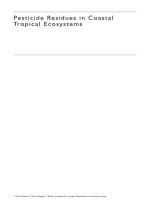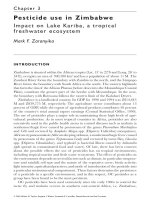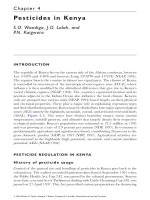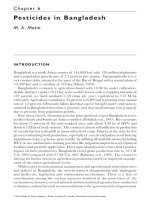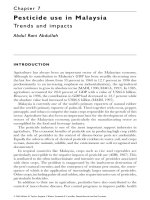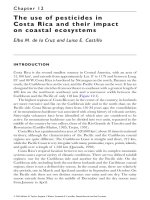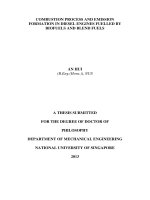Excellence in business communication 12e by vthill and brovee chapter 04
Bạn đang xem bản rút gọn của tài liệu. Xem và tải ngay bản đầy đủ của tài liệu tại đây (1.3 MB, 40 trang )
Copyright © 2017 Pearson Education, Inc.
Excellence in
in
Excellence
Business Communication
Communication
Business
Chapter 4
Planning Business Messages
Copyright © 2017 Pearson Education, Inc.
Learning Objectives
1.
2.
(1 of 2)
Describe the three-step writing process.
Explain why it’s important to analyze a communication
situation in order to define your purpose and profile your
audience before writing a message.
3.
Discuss Information-gathering options for simple messages,
and identify three attributes of quality information.
Copyright © 2017 Pearson Education, Inc.
Chapter 4 - 3
Learning Objectives
4.
(2 of 2)
List the factors to consider when choosing the most
appropriate medium for a message.
5.
Explain why good organization is important to both you and
your audience, and list the tasks involved in organizing a
message.
Copyright © 2017 Pearson Education, Inc.
Chapter 4 - 4
Understanding the
the Three-Step
Three-Step Writing
Writing
Understanding
Process
Process
(LO 1) Describe the three-step writing process.
Copyright © 2017 Pearson Education, Inc.
Chapter 4 - 5
The Three-Step Process
1
Plan
2
Write
Analyze Situation
3
Complete
Revise Message
Adapt to
the Audience
Gather Information
Produce Message
Choose Medium
and Channel
Proofread Message
Compose the
Message
Get Organized
Copyright © 2017 Pearson Education, Inc.
Distribute Message
Chapter 4 - 6
Planning Business Messages
Analyzing the
Situation
Choosing Media
and Channels
Copyright © 2017 Pearson Education, Inc.
Gathering
Information
Organizing the
Information
Chapter 4 - 7
Writing Business Messages
Adapting to the Audience
Copyright © 2017 Pearson Education, Inc.
Composing the Message
Chapter 4 - 8
Completing
Business Messages
Revising for Clarity
and Conciseness
Proofreading the
Final Product
Copyright © 2017 Pearson Education, Inc.
Producing the
Message
Distributing the
Message
Chapter 4 - 9
Optimizing Your Writing Time
50%
Copyright © 2017 Pearson Education, Inc.
25%
25%
Chapter 4 - 10
Analyzing the
the Situation
Situation
Analyzing
(LO 2) Explain why it’s important to analyze a communication
situation in order to define your purpose and profile your audience
before writing a message.
Copyright © 2017 Pearson Education, Inc.
Chapter 4 - 11
Defining Your Purpose
General
Purpose
Specific
Purpose
Copyright © 2017 Pearson Education, Inc.
•
•
•
•
•
•
To Inform
To Persuade
To Collaborate
What You’ll Accomplish
What Audience Will Do
What Audience Will Think
Chapter 4 - 12
Analyzing Your Purpose
Will the Message Change Anything?
Is Your Purpose Realistic?
Is the Timing of the Message Right?
Will Your Purpose Be Acceptable?
Copyright © 2017 Pearson Education, Inc.
Chapter 4 - 13
Developing an
Audience Profile
Copyright © 2017 Pearson Education, Inc.
(1 of 2)
Chapter 4 - 14
Developing an
Audience Profile
Copyright © 2017 Pearson Education, Inc.
(2 of 2)
Chapter 4 - 15
Using Audience Analysis to Plan a
Message
Copyright © 2017 Pearson Education, Inc.
Chapter 4 - 16
Predicting the Effects of Audience
Composition
Copyright © 2017 Pearson Education, Inc.
Chapter 4 - 17
Gathering Information
Information
Gathering
(LO 3) Discuss information-gathering options for simple messages,
and identify three attributes of quality information.
Copyright © 2017 Pearson Education, Inc.
Chapter 4 - 18
Informal Techniques for Gathering
Information
•
•
•
•
•
Consider the audience’s perspective.
Listen to the community.
Read reports and company documents.
Survey supervisors, colleagues, customers.
Ask your audience for input.
Copyright © 2017 Pearson Education, Inc.
Chapter 4 - 19
Uncovering Audience Needs
Needs That Are
Needs That Are
Apparent
Hidden
Copyright © 2017 Pearson Education, Inc.
Chapter 4 - 20
Providing Required Information
Is the Information Accurate?
Is the Information Ethical?
Is the Information Pertinent?
Copyright © 2017 Pearson Education, Inc.
Chapter 4 - 21
Selecting the
the Best
Best Combination
Combination
Selecting
of Media
Media and
and Channels
Channels
of
(LO 4) List the factors to consider when choosing the most
appropriate medium for a message.
Copyright © 2017 Pearson Education, Inc.
Chapter 4 - 22
The Most Common Medium and Channel
Combinations
Oral Medium
Written Medium
Visual Medium
Copyright © 2017 Pearson Education, Inc.
In-Person Channel
Digital Channel
In-Person Channel
Digital Channel
In-Person Channel
Digital Channel
Chapter 4 - 23
Oral Medium
In-Person
Channel
Digital
Channel
Copyright © 2017 Pearson Education, Inc.
•
•
•
•
•
•
Conversations
Speeches
Meetings
Phone Calls
Podcasts
Voicemail
Chapter 4 - 24
Written Medium
Print Channel
Digital
Channel
Copyright © 2017 Pearson Education, Inc.
•
•
•
•
•
•
Memos
Letters
Reports and Proposals
Tweeting and Texting
Website Contents
Book-Length Reports
Chapter 4 - 25
